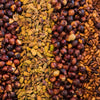Keto vs Low Carb for Weight Loss: Explained

Research shows that subjects lose more weight on keto than a simple low-carb diet. You might be surprised at just how important a role the “high-fat” component plays in fat loss.
The calories vs. macros debate has been solved... but what is it about carbs that matter so much? Why do people love them so much? How do good and bad carbs impact your health?
“Carbs” is a huge buzz word in the diet industry and everyone has an opinion on what you should be doing with them! Let’s dig a little deeper to separate fact from fiction and make this incredibly confusing landscape a bit easier to navigate.
Check out: Master Keto Food List with 100+ keto foods mapped out for you.
Keto vs Low Carb for Weight Loss
Much research exists that demonstrates that there is an increase in weight loss in subjects who follow a ketogenic diet rather than just a low-carb diet.This is due to several factors, including increased metabolic rate, the effect of ketosis, and the way your body uses and processes the different macronutrients.
What Are Macronutrients?
There are three macronutrients into which all foods we eat break down:- Carbohydrates
- Proteins
- Fats
Beans are another example of a plant-based protein source, but they are also high in carbohydrates (mostly from fiber) and contain trace amounts of fat.
Alcohol can be viewed as a fourth macronutrient because it provides caloric value, but keep in mind that it provides no other nutritional value and thus should NOT be considered the backbone of any healthy diet!
Why are Carbs so Controversial?
In the Standard American Diet (appropriately referred to as SAD), carbohydrates are by far the most abundant macronutrient because they are cheap, convenient, and usually processed and loaded with sugars.This is partially because of big food companies. The vast majority of the brands you see on the supermarket shelves, in commercials, and even online are owned by a few massive food conglomerates -- "Big Food", the food version of Big Pharma.
These companies discovered a few decades ago that sugar and carbohydrates is extremely cheap and easy to source and grow. To keep costs down and increase their profits, they pack their "food" offerings full of these ingredients.
So, they're extremely prevalent.
Unfortunately, they're also very addictive and easy to overeat. However, that doesn’t mean that ALL carbohydrates are bad. We just don’t tend to choose the ones that do our bodies good.
What’s the Difference Between "Good" and "Bad" Carbs?
The “good carbs,” also known as complex carbohydrates, contain higher levels of dietary fiber as well as essential micronutrients from vitamins and minerals.Examples of complex carbs:
- Colorful fruits and vegetables
- Unprocessed whole grains
- Starchy vegetables (corn, peas and potatoes)
- Beans
Examples of simple carbs:
- Sugar
- Refined white flour
- Corn syrup
- Fruit juices
Why Are Simple Carbs So Bad?
Think of glucose as the main currency for energy in the SAD. If you’re getting ready to run the Boston Marathon or hike Mount Kilimanjaro, having a lot of glucose circulating and stored in your system is a great thing! However, most of us drive in our car to sit at a desk all day, then come home to sit on the couch and watch TV before heading to bed. So, what happens to all that glucose that isn’t used?When we ingest carbohydrates, our bodies break them down and convert them to glucose (more rapidly for the simple carbs than the complex ones).
The glucose then makes its way to our bloodstream. In order for our cells to use this glucose currency as energy, our pancreas must excrete insulin, the magic key that unlocks glucose from our blood to send it to our cells for immediate use. If we have more glucose than immediate energy need (e.g. sitting at a desk for 8 hours a day), the excess will get stored in our muscles and liver as glycogen, which is the storage form of glucose.
What Happens to Excess Glucose?
We can only store a fixed amount of glycogen, which depends on many factors, the main one being our amount of muscle mass. Think of your glycogen stores as that closet in the spare bedroom.You can try to stuff as much junk in there as you want, but the closet is only so big, and eventually, the door will burst open and the junk will start to pour out and make a mess on the floor. Once your glycogen stores have been filled to the max, ANY excess glucose gets converted to fat and stored in new fat cells, which your body is MUCH more reluctant to use for energy than glucose from glycogen. So, at the end of the day, it’s not fat that is making you fat – it’s all that darn sugar!
Our bodies prioritize the metabolism of macronutrients in the following order:
Carbohydrates >>> Protein >>> Fat
When we are trying to lose weight, too many carbohydrates in our diet will hinder progress because our bodies are not willing to let go of fat stores until all of the glucose and glycogen have been used up. You can think of carbs as a roadblock to burning fat.When they are removed, or ingested minimally for immediate use, our bodies begin to look for alternative sources of fuel and only then, will start breaking down stored fat for energy.
Why Isn't Low-Carb/High-Protein as Effective?
Most people find cutting carbs out of their diet challenging for a number of reasons: they’re convenient, they’re addictive (hello, carb cravings!), and they feel hungry all the time. Most standard “low-carb” dieters tend to replace dietary carbs with higher levels of protein, which is problematic because our bodies will convert excess protein to glucose through a process called gluconeogenesis. So, while they may not be eating carbohydrates, their body is still running off glucose which perpetuates the carb/sugar cravings.The low-carb/high-protein way of eating is less sustainable because the dieter usually gives in to carb cravings. Plus, it’s also less effective because this diet never removes the glucose roadblock to get your body into fat-burning mode. However, when we replace the carbs in our diet with good sources of fat, we find we are fuller longer, carb cravings disappear, and hunger decreases while energy increases. As our bodies become more and more efficient at utilizing fats for fuel in place of glucose from carbs and protein, they also break down stored body fat for energy, resulting in greater weight loss when compared to a standard “low-carb” diet.
How To Stop Craving Carbs
This is where the ketogenic diet comes in. The keto diet is a low-carb, moderate protein, high-fat diet. The typical macro breakdown of the keto diet is:- 75% fat
- 20% protein
- 5% carbohydrates
The key to making the keto diet work is getting your body into a state of ketosis. Our bodies run on one of two fuel sources: glucose or ketones. Carbs, which make up the bulk of most diets, are converted into glucose, which is then burned for fuel, while excess carbs are stored as body fat.
However, when carbs are not readily available for an extended period of time, our bodies switch from running on glucose to running on ketones. When your body starts running on ketones, that means your body is in ketosis. Over time, and as you enter ketosis, your body stops craving carbs and starts burning fat, which often leads to weight loss.
Ketones are the metabolic fuel our bodies produce when burning fat, instead of carbs, for fuel. There are three types of ketones:
- Acetoacetate - Acetoacetate is produced as our bodies break down long- and medium-chain fatty acids for fuel.
- Acetone - Our bodies produce acetone as a byproduct of acetoacetate.
- Beta-hydroxybutyrate (BHB) - Though technically a molecule instead of a ketone, BHB is the most important ketone body for the ketogenic diet. It’s produced in the liver from acetoacetate, and floats freely through the bloodstream, where it’s turned into adenosine triphosphate (ATP), which is used by the body for energy.
The Benefits of Replacing Carbs with Fats
The best-known benefit of the keto diet is weight loss, which naturally occurs as the body switches from burning carbs to burning fat. However, the benefits of the keto diet aren’t limited to shedding a few pounds.Here are some other benefits:
- Mental clarity and focus
- Decreased carb cravings
- Suppressed appetite (fat is very satiating)
- Increased energy
- Oils (MCT, olive, coconut, avocado)
- Fruits (avocados, olives, berries)
- Seafood and grass-fed meats (salmon, bacon, and beef)
- Low-carb vegetables (leafy greens, broccoli, cauliflower)
- Dairy (cheese, full-fat plain yogurt, and heavy cream)
- Nuts and seeds (macadamia nuts & nut butter, almond flour, and chia seeds)

Take-Home Message
Any diet that cuts out simple carbohydrates and relies more on “real foods” from complex carbs, fats, and proteins will be effective at improving your health. However, if sustainable weight loss is your main goal, a diet that is low in carbohydrates, high in fat, and moderate in protein (i.e. the ketogenic diet) will be a more effective, sustainable, and enjoyable option.↑
-
Posted in
Authority Article, Nutrition, Nutrition Article, Weight Loss




